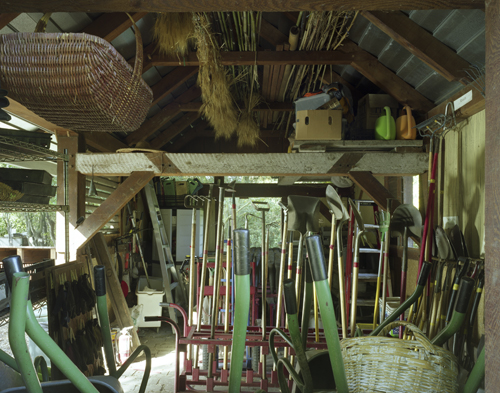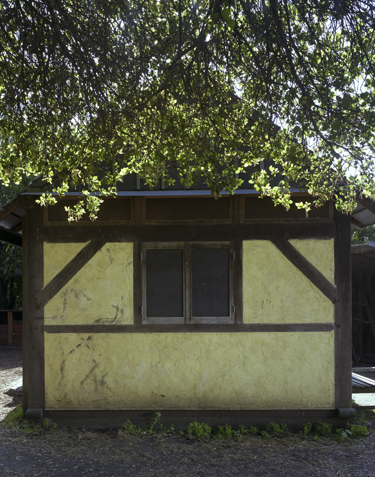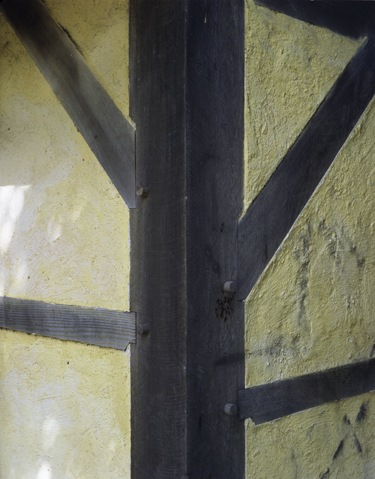
Berkeley, California (photo: Richard Barnes)
I recently had the good fortune to spend a day working with photographer Richard Barnes. Richard is helping me document my work for the Edible Schoolyard over the past decade as I develop a book proposal about this and related Deep Craft projects and philosophy.In Spring of 1998 I was commissioned to design and build a tool shed for the nascent Edible Schoolyard with a grant from the Center for Ecoliteracy, a Berkeley-based non-profit founded by physicist Fritjof Capra. The project gave me a unique opportunity to test some ideas I was beginning to develop about vernacular architecture, in response to the urban fabric of the San Francisco Bay region, where Ene and I had recently settled. The tool barn was a model project, with many nuances and object lessons, and its story will form the foundation of my book. I will be outlining the story of ‘Tool Barn at the Edible Schoolyard’ in detail in the PROJECTS pages of this site as I compile documentation.

East elevation (photo: Richard Barnes)
Working with Richard gave me a chance to revisit the project and see it with fresh eyes. Richard is an astute observer, with a profound understanding of Arts and Crafts architecture and a gift for ‘forensic’ documentation. Our collaboration consisted of translating what for me is a process-driven approach to architecture into visual artifact.Following several email exchanges where we found aesthetic common ground and many shared connections, we met on site in January to plan a shooting strategy based upon how the tool barn had been adapted to daily use. I was relieved to find Richard to be witty, affable and frank, and we got along immediately. Anything resembling a strategy grew out of our wide-ranging conversation over afternoon tea, prompted by Richard’s penetrating questions.
We met again a few weeks ago on the eve of the planned shoot, and continued the conversation over a three hour dinner at Chez Panisse. We decided to let the following day unfold in response to the weather and shifting light patterns. We would simply carry our conversational collaboration to the site and make a day of it. ???? ??? ???? I would be Richard’s assistant, and he would tell me what to do. ????? ???? ???? The next morning I brought coffee and sandwiches, and we spent a delightful day in the garden, talking to passersby and making photographs in a logic that asserted itself automatically, informed by our late night musings.Though I had visited the tool barn sporadically over the years, I had not spent a full day in the garden since I built the structure some ten years ago. ????? ????? I was able to recapture the visceral sense I originally had on site, and remembered how this translated into the conception of the building. I remembered the feeling of just standing there before anything was built, smelling the air, hearing the birds and feeling the warmth of the sun over a cool breeze coming off the bay to the West. It was an oddly moving experience, a ‘time out of time’. I remembered how I thought of each elevation as a kind of portrait of the cardinal points of the compass, tuned to the site and its proposed use patterns, and how I graded the material accordingly. I remembered how my work force consisted mostly of middle school students with ‘learning disabilities’, for whom school offered no reward system for their kinesthetic talents.

gloves dry in the sun (photo: Richard Barnes)
I was deeply touched by the way the building had been adapted by the gardeners, evidence of the cyclic and interdependent relationship between design, making and use I had theorized. The building had earned a purposefulness that I had only imagined and left open to the forces at play. Seeing it all working so well prompted me to recall another adage of mine which guided the structural/material program for the building, which forms the third axiom in the Deep Craft manifesto:
The building is framed with timbers from the top 50 feet of a single, storm fallen Coast Redwood, locally milled from a thousand year old tree. It is made to be easily disassembled and re-used if necessary, as it is pinned together with oak ‘trunnels’, which were hand-tapered and pegged in place by the students. The building is an homage to that specific tree, and might last a thousand years if its evolving design continues to influence the forces of entropy that have thus far shaped it into something beautiful.

framing detail (photo: Richard Barnes)
Comments are closed.